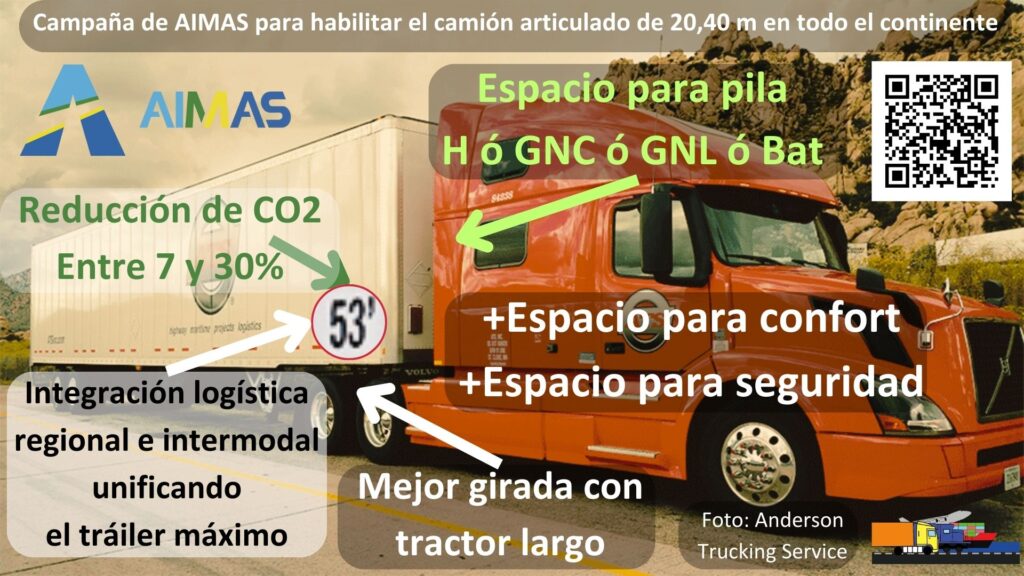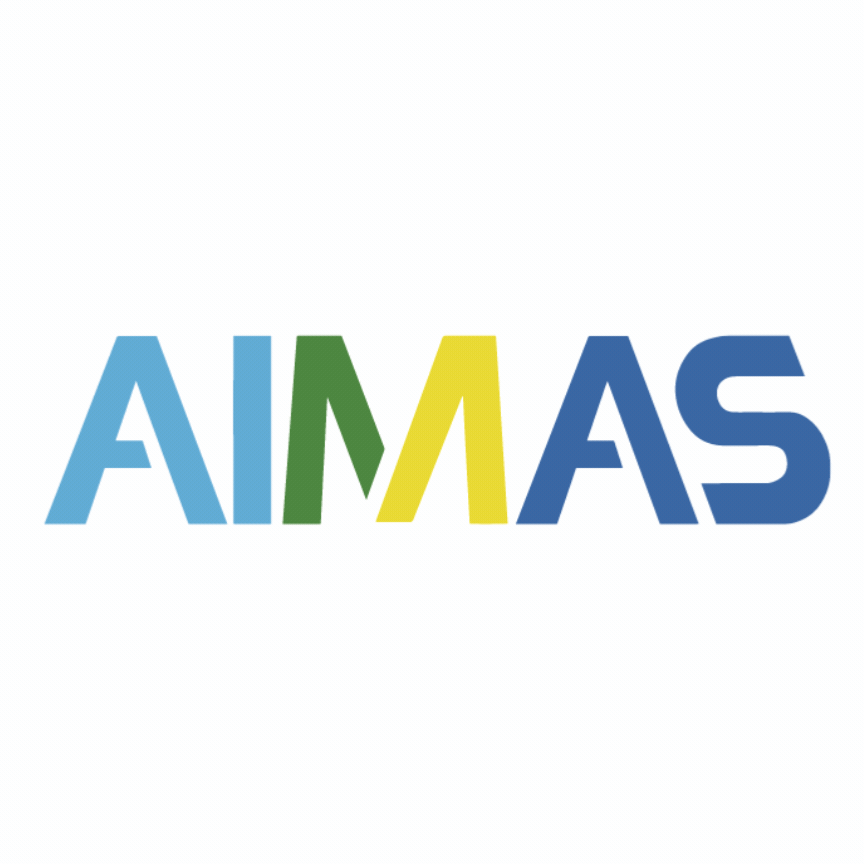
Request to the National, Provincial and Municipal Governments for:
Continental clearance for 20.40 metre long trucks
Continental clearance for 16.16 m (53 ft) trailers
Continental consistency for the 20.40 m truck and the 16.16 m trailer will facilitate logistics integration and the enabling of the 53-foot container for ships, trains and trucks.

Collective, unlimited and free signature of this document

The Intermodal Association of South America has its institutional email [email protected] and its WhatsApp +54 9 11 2191 1985 for queries and to request access to the digital signature provided by the NOVANDI Company of Mexico, in collaboration with AIMAS and with this initiative.
The AIMAS Association will present the signed documentation to the governments, and it will do so on its own or in conjunction with other organizations that are also interested in:
- The economic development of our American Continent
- The safety and comfort of drivers
- The reduction of the carbon footprint.
AIMAS, Octubre de 2024
We invite you to sign this document to request each country, state, province, municipality, region to enable/authorize the circulation of trucks with a length of 20.40 m, tractor and semi-trailer.
Why does AIMAS propose this length for the truck plus trailer?
Because the Intermodal Association of South America has, in its Bylaws, the mission of promoting intermodalism in the southern region of the American Continent, and the standardization of the truck set (tractor plus trailer) is one of the key pieces for the evolution of this Transport Economy.
Advantages for the Economy with the 20.40 m truck
Enabling the maximum length of the truck and the semi-trailer will allow:
- The trend towards a uniform general cargo transport unit between the countries of the Region;
- It balances local, regional and continental competitiveness;
- It will open the way to the incorporation of the 53-foot container for the exchange of equipment between companies, countries and on the continent on ships, railroads and trucks;
- It will collaborate in the reduction of the carbon footprint;
- It will collaborate in the intermodal integration of the truck – train – ship transport chain, which will facilitate the Intermodalism and will provide increased productivity and benefits to all links in the supply chain;
- Strong expansion of the logistics offer to every corner of the American Continent.
The maximum length of 20.40 m will allow:
- Tractor with long nose and/or long cabin and/or space for battery (electric, hydrogen, LNG, CNG):
- It will collaborate in safety for the driver;
- It will collaborate in comfort for the driver;
- It will help in the maneuverability of the tractor-trailer set;
- It will expand the offer of tractor brands and models.
The collective signature of the interested parties such as clients, transporters, logisticians, professionals, public sector, etc., will facilitate:
- The presentation of the subject before the authorities so that each federation and interested sector of each country, province, region, municipality requests or helps to request such authorization;
- It will encourage railroads, ports, shipping companies and truck companies to adjust their calculations and plans towards a more cooperative, collaborative, competitive transport economy model based on innovation, efficiency and excellence.
Adopt a standard:
- That has been the fruit of decades of experimentation and business, academic and state agreements in North America and that through these same tests will provide benefits to the rest of the Continent;
- That is already proven in 93% of the economy of America, where 40% of the inhabitants live;
It will add a container that will be competitive in domestic and regional markets over trucks, trains and ships, as it already is in North America:
- Which will reduce operating costs by 40% in the 53-foot container chain compared to the 40-foot container in the domestic and regional order.
- Which will reduce up to 30% of the carbon footprint in a domestic containerization with a 53-foot container compared to the 40-foot option.
- Which will enhance domestic, regional and continental integration based on standardized and much more competitive logistics.
- Which will allow the transshipment of 50% or more of the 40-foot light cargo containers of ocean trade, which will reduce costs and carbon footprint by more than 30% (3 40′ containers will be transshipped in 2 53′ containers).
What happens today due to the lack of a broad and homogeneous standard
- The trucks authorized (in length) in a country cannot transport to or from other countries due to the difference in the maximum length.
- In some countries, the standard is not homogeneous from province to province.
- The demand for long-hood or long-cab tractors is limited to only front-end trucks and without space for a sleeper cab because with these the maximum length of the truck with the trailer included could be exceeded.
- The life and safety of the driver is exposed to greater insecurity due to the lack of a long hood and to discomfort due to restricted space for resting and eating.
- The shorter length of the truck and the trailer imposes higher costs and more emissions in the transport of valuable goods (mass consumption), because the load is restricted by volume.
- The length of the trailer does not allow for containerization of domestic and regional trade, since with the 40-foot container it is not competitive, since any trailer can carry at least 24 pallets, while the 40-foot container can only hold 20 pallets.
- The restriction imposed by the 40-foot container on the domestic market due to its low capacity prevents the intermodalization of the system, thus preventing carbon footprint reductions of between 7 and 33%.
- In the case in which the intermodal chain with the 53-foot container could be carried out by combining with a ship, the footprint reduction would exceed 90%.
- The lower competitiveness of the truck moving a 40-foot container in the land mile makes intermodalization with the ship difficult in domestic and regional cabotage.
- The direct journey of a full truck (without a container) in domestic and regional cabotage is more efficient than the combination with a ship when the container is 40 feet.
This proposal only concerns the maximum lengths
- It does not propose any modification or unification in the maximum weights of trucks.
- It does not propose any modification of the total capacity (gross weight) of containers in any of their maritime or non-maritime measurements.
This proposal does not replace the 20 or 40 foot ISO container.
- This initiative proposes the freedom to use the 53-foot container in domestic, regional and continental markets, whether by truck, train or ship.
- The 53-foot container has a Palletwide width = Specific to maximize the use of the interior surface by standard pallets from Europe and the entire American Continent (American Pallet and Arlog).
- In intercontinental ocean transit, in the future, the 53-foot container will only hold a fraction of the volume: that of the most valuable and lowest density loads.
Management
The electronically signed copies will be unified for submissions to the authorities of each traffic or road jurisdiction as appropriate. AIMAS will report on the steps and results.
AIMAS, October 2024
Reference information
El estándar del Siglo XXI Impacto del contenedor de 53 pies en camiones y trenes
¿Cuántas paletas entran en un contenedor?
Productividad verde del contenedor de 53 pies Superficie productiva del contenedor de 53 pies
AMTI, CANACAR, FADEEAC, CAME, CETAC RS, Red PBIP apoyan el 53 pies
Datos técnicos del contenedor de 53 pies
26% del PIB Global y 93% del PIB de América tiene contenedor de 53 pies
We invite those who consider it necessary to expand the logistics offer, increase benefits to all links and reduce the carbon footprint, to sign this request to the authorities, sending an email to [email protected] with their data or to WhatsApp +54 9 11 2191 1985.
With the Electronic Signature Platform of our Gold Honorary Partner and strategic ally NOVANDI, we will send you the document so that you can easily sign it.
AIMAS – Asociación Intermodal de América del Sur CUIT 33-71609939-9 – Matrícula 44.916 – Organizada: 27/5/2017 – Fundación: 4/12/2017 Alsina 19 6to piso Of. 9/10 – (B8000IHA) – Bahía Blanca – Buenos Aires – Argentina Cel. solo mensajes: +54 9 11 2191 1985 –www.aimas.org.ar |

